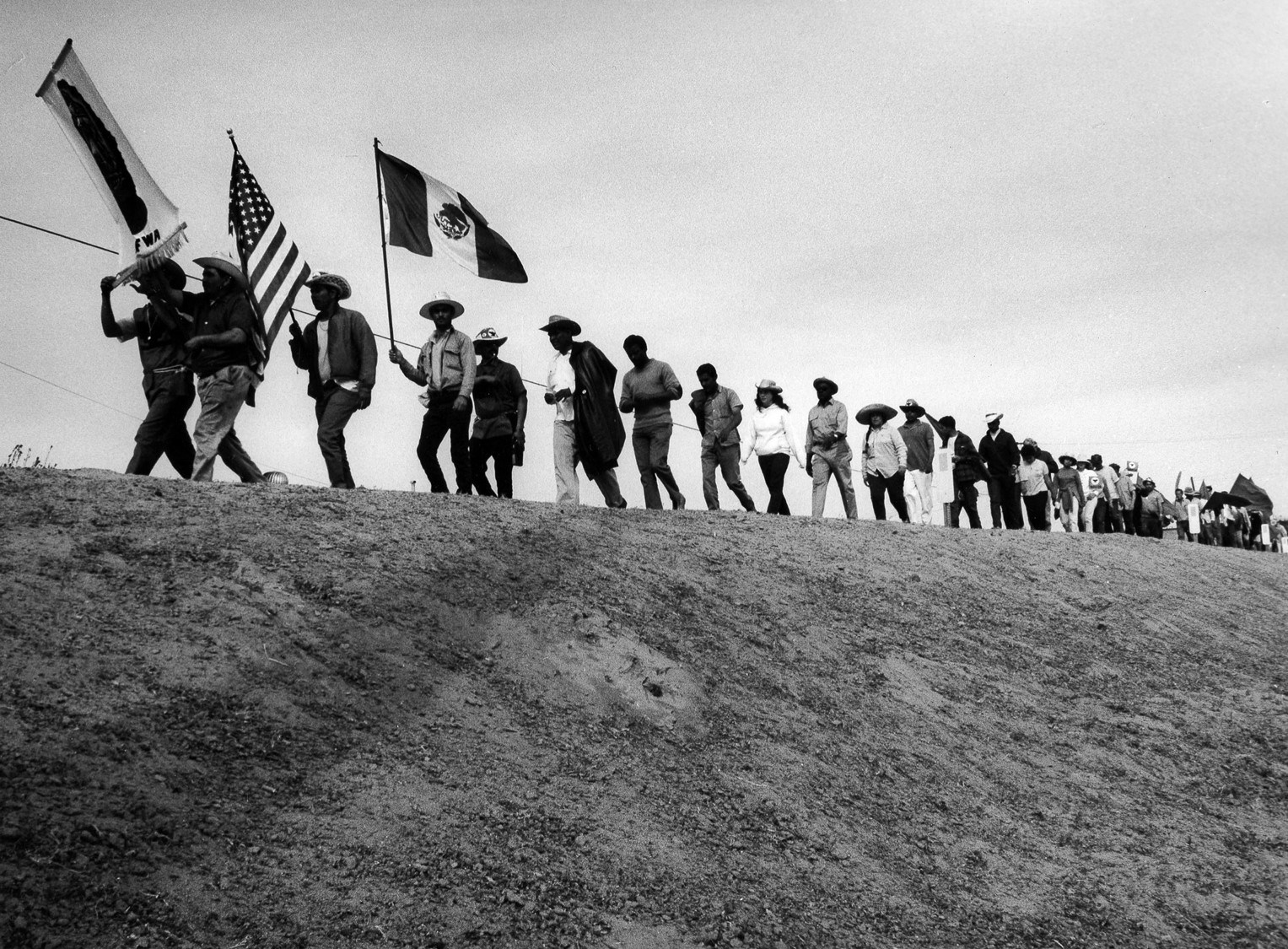With a banner of Our Lady of Guadalupe at their head, 70 striking farmworkers led by Cesar Chavez leave Delano in Kern County on a “perigrinacion” to Sacramento, nearly 340 miles away. The 25-day march – they call it a “pilgrimage” – is sparked by one of the area’s largest grape growers spraying pesticide on striking farmworkers.
The perigrinacion is also designed to draw attention to the suffering of farmworkers who strike against table and wine grape growers on September 8, 1965, seeking a pay raise and improved working conditions. The strike is started by the largely Filipino American Agricultural Workers Organizing Committee. They ask Chavez and Dolores Huerta and their largely Latino National Farm Workers Association to join the strike. Four months after the march to Sacramento, the two groups merge and become the United Farmworkers.
Before the farmworkers leave Delano for Sacramento, El Plan de Delano is read to the group. The manifesto, written by Luis Valdez, explains the reasons for the strike and the union’s goals. Read at each stop along the march up the Central Valley, El Plan de Delano says in part:
“We are conscious of the historical significance of our Pilgrimage. It is clearly evident that our path travels through a valley well known to all Mexican farm workers. We know all of these towns of Delano, Madera, Fresno, Modesto, Stockton, and Sacramento, because along this very same road, in this very same valley, the Mexican race has sacrificed itself for the last hundred years. Our sweat and our blood have fallen on this land to make other men rich. The pilgrimage is a witness to the suffering we have seen for generations.
“The penance we accept symbolizes the suffering we shall have in order to bring justice to these same towns, to this same valley. The pilgrimage we make symbolizes the long historical road we have traveled in this valley alone, and the long road we have yet to travel, with much penance, in order to bring about the revolution we need, and for which we present the propositions in the following PLAN:
“This is the beginning of a social movement in fact and not in pronouncements. We seek our basic, God-given rights as human beings. Because we have suffered — and are not afraid to suffer — in order to survive, we are ready to give up everything, even our lives, in our fight for social justice. We shall do it without violence because that is our destiny. To the ranchers, and to all those who opposes, we say, in the words of Benito Juarez, “EL RESPETO AL DE-RECHO AJENO ES LA PAZ.” (Respect for the rights of others is peace.)
The marchers leave Delano and head up Highway 99, covering about 15 miles a day. Members of the press and the Federal Bureau of Investigation follow. The walkers, who light candles as they pass through towns, are welcomed and fed by farmworkers along the way. Like several of the other walkers, Chavez develops nasty blisters that make each step painful. His 39th birthday falls on the 15th day of the pilgrimage. By Stockton, the number of marchers swells to some 1,500. National publicity increases. A week before arriving in Sacramento Chavez is told by the vineyard that sprayed the striking farmworkers with pesticide that it wishes to negotiate a union contract. It’s the first time a farmworkers union is recognized by a corporation.
On Easter Day 1966, the marchers walk down Capitol Mall and up to the steps of the Capitol. Farmworker Roberto Roman, who has carried a wooden cross draped in black cloth from Delano, redrapes the cross in white and covers it with flowers.
To the crowd, Dolores Huerta says:
“The developments of the past seven months are only a slight indication of what is to come. The workers are on the rise. There will be strikes all over the state and throughout the country because Delano has shown what can be done and the workers know they are no longer alone. The agricultural workers are not going to remain static. The towns that have been reached by this pilgrimage will never be the same.
“On behalf of the National Farmworkers Association, its officers and its members, on behalf of the all of the farmworkers of this state, we unconditionally demand the governor of this state, Edmund Brown, call a special session of the Legislature to enact a collective bargaining law for the farmworkers of the state of California. We will be satisfied with nothing less.”
Footage of Huerta and Chavez speaking.
Nine years later, Gov. Edmund G. Brown Jr. signs California’s landmark Agricultural Labor Relations Act, the aim of which is “to ensure peace in the agricultural fields by guaranteeing justice for all agricultural workers and stability in labor relations.” The law creates the Agricultural Labor Relations Board and gives farmworkers the right to collective bargaining, the fist law of its kind in the nation.
TOP PHOTO: Farmworkers March from Delano to Sacramento on the 1966 Perigrinacion
(United Farmworkers)

